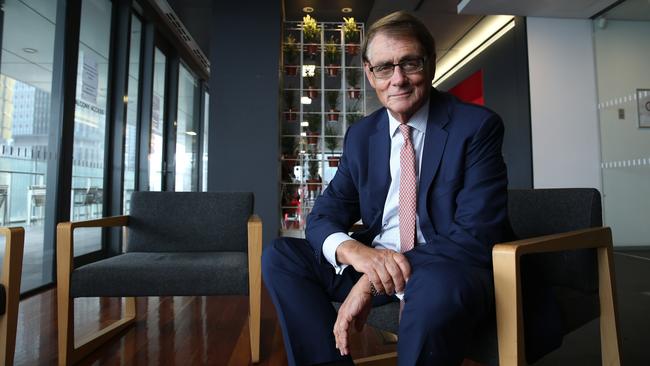More RBA interest rate cuts on horizon, analysts say
Economists see faster rate cuts and a higher chance of unconventional monetary policy ahead.

Australia is increasingly being drawn into a race to the bottom on interest rates.
Economists see faster rate cuts and a higher chance of unconventional monetary policy after the Reserve Bank appeared to strengthen its resolve to achieve its targets, domestic and US economic data disappointed, and the likelihood of faster US interest rate cuts increased this week.
Westpac’s highly regarded chief economist Bill Evans still expects the RBA to wait until February before it cuts the cash rate to 0.5 per cent, but now sees a December cut as “a real possibility”.
The RBA delivered a widely expected 25-basis-point cut to a record low of 0.75 per cent this week.
RBA governor Philip Lowe said: “It is reasonable to expect that an extended period of low interest rates will be required in Australia to reach full employment and achieve the inflation target.
“The board will continue to monitor developments, including in the labour market, and is prepared to ease monetary policy further if needed to support sustainable growth in the economy, full employment and the achievement of the inflation target over time.”
While the consensus remains for another cut in February, economists at AMP Capital, Barclays, Morgan Stanley, Nomura and UBS now predict the RBA will cut again next month.
While some economists expect faster fiscal stimulus from the federal government to rescue the economy, many now feel the RBA will be forced to dabble with so-called unconventional policies such as quantitative easing — asset buying — if the Morrison government doesn’t further loosen the purse strings, other central banks keep cutting (putting upward pressure on the dollar) and more economic stimulus is required after the RBA hits the near-zero “effective lower bound” of interest rates.
The global experience suggests that if Australia adopts QE, it could be locked into a decade of near-zero interest rates, potentially fuelling asset bubbles and stress for those relying on interest income.
Analysis from Goldman Sachs this week showed the RBA’s own macroeconomic model predicted a minus 1 per cent cash rate, or a near-zero rate plus a $200bn QE program, would be needed for the RBA to achieve its full-employment and target-inflation goals.
The money market is now fully priced for a 0.5 per cent rate by February and pricing implied a 0.35 per cent cash rate by next August as investors increasingly see an eventual move to 0.25 per cent.
The limited pass through of the RBA’s 25-basis-point interest rate cut to mortgage rates by the banks this week was one factor leading economists to predict faster cuts by the RBA.
While the sharemarket bounced slightly on Friday amid hopes that weak US economic data would convince the Federal Reserve to cut at its October 30 meeting — potentially lifting the chance of a November cut from the RBA — the S&P/ASX 200 lost 3 per cent this week — its worst week since November last year — as fear of a looming global recession continued to grow.
As with most domestic data apart from house prices, August retail sales and September car sales data in Australia showed little or no traction from interest rate and tax cuts so far.
But Westpac’s Mr Evans said market pricing of a 50 per cent chance of a cut in November was “too high” after the RBA cut the cash rate to a record low of 0.75 per cent as expected this week.
In his view, central banks usually “bias their comments” when they make policy changes to “justify their decision” and the RBA’s “bolder objective” of “full employment” wasn’t justified by the data.
Indeed, with the unemployment rate trending away from the RBA’s estimate of the full-employment rate, and labour demand indicators suggesting jobs growth will slow, the RBA’s guidance that it is “prepared to ease further if needed to reach full employment” (all one of its mandates) “seems curious and is probably less significant than markets may have assessed”.
The RBA’s choice of the term “if needed” as a qualifier in regard to preparedness to ease monetary policy further arguably implies that the central bank will take some time to assess the impact of the three cuts in this cycle before moving again, according to Mr Evans.
He also said the RBA would be mindful of the negative response of the Westpac Melbourne Institute Consumer Sentiment Index to the consecutive cuts in June and July, as it reflected an apparent “spooking” of the consumer around the policy action.
But with August retail sales bouncing a meagre 0.4 per cent month on month, non-food retail down 1.9 per cent year on year and small retailing down 2.5 per cent, and September car sales collapsing 6.9 per cent on year (the 18th straight year-on-year fall), personal credit contracting the most since the global financial crisis and other indicators “muted”, UBS now predicts the RBA will cut to 0.5 per cent in November and 0.25 per cent in the first half of 2020.
The RBA’s Financial Stability Review on Friday warned: “Uncertainty about the outlook for global economic growth has increased … with a greater chance of weak growth.”
The RBA said: “In the near term, risks from falls in housing prices have been reduced but still exist”; while “potential risks from a resurgence” in house prices are “further out”.
UBS chief economist George Tharenou estimated that if households spent half the money from recent tax and interest rate cuts on retail sales, they would increase to 5 per cent on year.
“But critically, there has been no material pick-up of consumer data so far after the second quarter dropped to the weakest since the global financial crisis,” Mr Tharenou said.




To join the conversation, please log in. Don't have an account? Register
Join the conversation, you are commenting as Logout